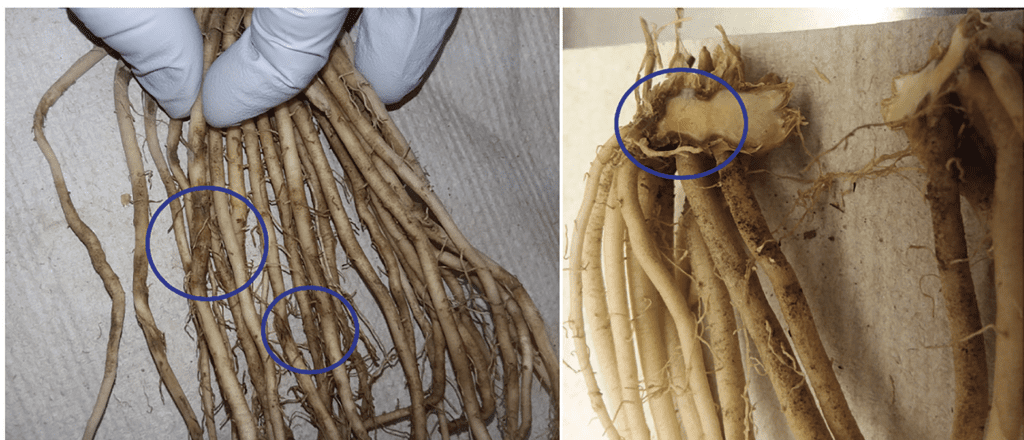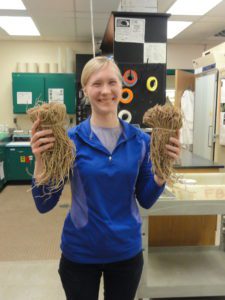

Jun 19, 2019Pathogens in asparagus crowns researched
Cleaner crowns are a way to avoid rot in asparagus crowns, stems and roots, and identifying the fungi on the plants may help manage those pathogens.
A new study by Michigan State University (MSU) is examining the role pathogens play in limiting asparagus yields. Sara Getson, a master’s degree student studying under Mary Hausbeck, chair of MSU’s Department of Plant, Soil and Microbial Sciences, spoke about her research at Oceana Asparagus Day, held in March in New Era, Michigan.
Michigan is the country’s second-highest asparagus-producing state, behind Washington, and Oceana and Mason counties, in the northwest corner of the state’s lower peninsula, together are Michigan’s largest asparagus-growing region.


Photo: MSU
“The take-home message from our research thus far is to employ strong management strategies at the nursery level,” she said. “Since fusarium is a seed-borne pathogen in asparagus, control tactics are most effective and feasible before transplanting into the production fields.”
She conducted a survey experiment to find out what species of fusarium are associated with one-year-old transplants, and then which of those are capable of causing disease in asparagus. A similar survey hasn’t been conducted in nearly 30 years in Michigan asparagus, and a better picture of the pathogens would help inform management recommendations seeking to target those specific disease-causing fusaria species, she said.
One-year-old crowns of asparagus were pulled from three growers, two from Oceana County and one in southwest Michigan’s Berrien County – another production area in the state.
Preliminary results showed that fungi from the fusarium genus were present in crowns from all three areas and between the different cultivars that were sampled – Jersey Supreme, Guelph Millennium and Guelph Eclipse. It was also present in both fields that had been fumigated before and those that had not. Infection rates ranged from 25% to 47%.
The concern for asparagus growers is that certain fusarium species – not all – can weaken the plant if it is stressed by high heat and drought, causing stem, crown and root rot.
Growers can diagnose the presence of fungi from the fusarium genome to an extent. Chlorosis (yellowing) and dying back of the ferns is one symptom. Digging up asparagus crowns, especially of mature plants, can be a prohibitively difficult, but on asparagus crowns and roots – the fusarium lesions appear as red-brown sections on the roots and in a cross-cut section of the crown.
Getson is cultivating tissue samples from the crowns in the survey study. The next step is sequencing the DNA from the samples to see which fungi are present. She will later grow asparagus seedlings and inoculate them with different fusarium species collected to see if they can cause disease.
“Some are known to be pathogenic,” Getson said. “Some are known to just hang out.”
Previous studies have found the presence of pathogenic species including proliferatum, oxysporum and moniliforme.
“It will be interesting to see if they’ve shifted at all,” Getson said.
In the meantime, she said, the most effective practice continues to be soaking crowns in fungicide prior to their being transplanted. According to a separate study Hausbeck’s group conducted, biological fungicide products didn’t seem to have much effect.
“Industry standard treatment of Cannonball WP was the only treatment that resulted in statistically healthier crowns compared to the untreated control,” according to the study proceedings published for Oceana Asparagus Day. “Cannonball-treated crowns produced seedlings with significantly increased fern weight” compared to other products.
Fusarium fungi species can linger in the ground years after they are spread by a new planting, Getson said.
“A major reason that we are targeting the nursery crowns and the seedbeds for management is primarily because once you get the asparagus crowns into the production field, they can be susceptible to whatever that’s out there,” she said. “And once the crown is established, it’s really difficult to get materials down to the crown, the root system.”
– Stephen Kloosterman, associate editor
Above: Asparagus roots, left, and crown, right, exhibiting symptoms of fusarium infection. Photo: Michigan State University/Sara Getson














